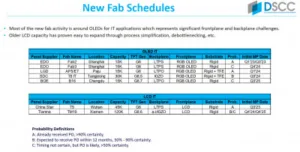I was just looking down my list of topics for Display Daily when I spotted a news item that immediately voted for itself as the hot topic today. The Yonhap News in Korea reported that Samsung Display’s CEO had said yesterday at IMID that his firm would go ahead with a new fab for OLEDs in IT.

The decision to go ahead had been widely expected, but nevertheless, it’s a big step for the industry. The fab will use G8 substrates at 2,200 x 2,500 mm with a planned production date of 2024. The output from the fab will go for OLEDs for use in IT applications – mainly notebooks and tablets where the advantages of lower weight and bulk have a real benefit to users.
SDC is not the only vendor looking at this kind of development and DSCC presented this table of possible fabs at the SID/DSCC Business Conference this year.
 David Naranjo presented this table – the SDC fab is detailed as expected.
David Naranjo presented this table – the SDC fab is detailed as expected.
Of course, OLED does have some downsides, particularly in power consumption in IT applications, where the screen image is quite bright and, historically, in being susceptible to image burn where the same static content is displayed for a long time. There is good news in this area, as we have reported over the last couple of years.
Good Blue OLED Materials Should Arrive
First, there is the arrival of phosphorescent blue OLED materials from UDC which expects to be in volume production by the time the G8 fab gets going. That will give a big boost to the efficiency of the devices and could lead to lower current density, which will help with image sticking. Other firms are also optimistic about breakthroughs in developing efficient blue OLED materials, which have been the real weakness of OLEDs up to now.
The second area that could really help is the development of ‘tandem’ structures for OLEDs, where two sets of OLED layers are stacked on top of each other. This has big advantages in boosting lifetimes and brightness. Up to now, LG Display has been one of the mains suppliers of tandem OLEDs for use in automotive applications where lifetime qualification processes are very stringent. There have been lots of reports over the last year or two that SDC was developing tandem OLEDs to meet the requirements of Apple to allow its OLEDs to be used in Apple’s iPads in 2024. (a search of the terms ‘samsung apple tandem oled’ gives 19 results on DisplayDaily.com. The Elec reported early this year that SDC was waiting for confirming orders from Apple for iPad displays before going ahead with the new fab.
SDC Goes Vertical
The SDC fab is expected to make RGB OLEDs using a vertical deposition process which avoids the ‘sag’ in the mask that makes the horizontal deposition challenging at these large substrate sizes. Sometimes, in larger OLED substrates, deposition is done on half the panel at a time and no doubt the specialist analysts on the supply chain and equipment, such as DSCC, will dig out whether Samsung will go for a full G8 substrate or make the panels in two halves. That will depend on how good the equipment is and how confident Samsung is that it will get the yields it wants.
Monitors Might Get a Look-in
While notebooks and tablets are the main target markets, there will be a desire for OLEDs for monitors as well. However, Taiwan is dominant in the monitor business at the moment and is working very hard to make miniLED the preferred solution for most monitors. Power consumption is less of an issue for desktop monitors and there is less concern about bulk and thickness, so miniLED has some advantages. At the SID/DSCC Business Conference, David Naranjo of DSCC said that ‘advanced monitors’ using OLEDs or miniLEDs had grown from 0.8% to 2.3% of the monitor market in 2021, with miniLED winning in monitors and tablets (because of Apple) and OLEDs winning in notebooks.
Asus at the moment dominates OLED notebooks with 71% in Q1 2022. Apple had 98% of the minLED notebook market, while Samsung sold 44% of the OLED tablets.
ThePrint also reported that SDC had shown a 77″ QD-OLED at the IMID event and TheElec reported that the firm would add a 49″ version as well. That should be a very compelling gaming monitor or TV.
The Elec also reported that Samsung has been able to improve its TACT time for its QD-OLED panels, as well as improving yields. The better process time means that it expects to boost its capacity from 30K per month (G8) at the moment to the ‘late-30,000’s. (BR)

